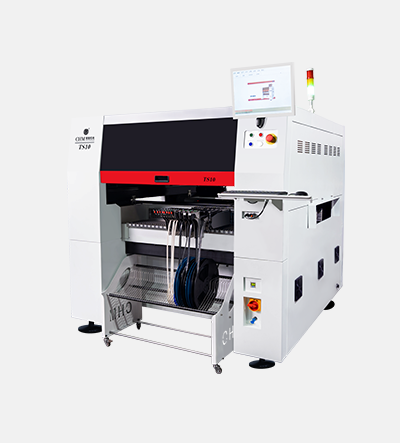Component Placement Accuracy Issues in SMT Pick and Place Machines
Precision in component placement remains the critical performance metric for SMT pick and place machines, with misalignments as small as 50 µm causing functional failures in advanced PCB designs.
Diagnosing Component Placement Errors and Skewing
Vision-assisted diagnostic protocols identify three primary error types:
- Angular skew (±3° rotation errors) from nozzle grip instability
- X/Y offset deviations exceeding 25 µm due to stage positioning drift
- Z-axis pressure variance causing tombstoning in 0402 components
Root cause analysis typically reveals nozzle wear (37% of cases), improper feeder engagement (29%), or machine vibration exceeding 2.5 Gs (IPC-9850 standards).
Calibration Techniques for Optimal Machine Accuracy
Three-phase calibration cycles restore placement precision:
- Daily: Vision system fiducial recognition checks using NIST-traceable calibration boards
- Weekly: Laser-aligned stage positioning verification with ±5 µm tolerance
- Monthly: Full machine thermal compensation for linear motor expansions
Critical calibration parameters include ambient humidity compensation (±60% RH requires +8% Z-axis offset) and component size-specific vacuum pressure profiles.
Maintenance Protocols to Sustain Placement Precision
Scheduled maintenance intervals now incorporate:
- 500-hour nozzle inspection/replacement cycles
- Linear encoder cleaning with IPA-grade solvents
- Vacuum system leakage testing at 75 kPa
Facilities implementing ISO 14644-1 Class 7 cleanroom standards achieve 25% longer maintenance intervals while maintaining placement accuracy below 20 µm.
Resolving Fiducial Recognition Failures in SMT Pick and Place Operations
Root Causes of Inaccurate Fiducial Recognition
Contaminated optics account for 42% of fiducial recognition errors, with dust or solder paste residue obscuring camera lenses. Calibration drift from mechanical vibrations or thermal fluctuations alters reference points, while PCB warping creates inconsistent surfaces for recognition.
Vision System Optimization Strategies
Multi-spectral imaging improves contrast ratios by 60% compared to monochromatic systems. Regular lens cleaning protocols and environmental monitoring (temperature ±23°C ±1°C, humidity 40-60% RH) stabilize recognition consistency.
Solving Component Pick-Up and Release Failures in SMT Placement
Troubleshooting Vacuum Nozzle Malfunctions
Vacuum nozzle malfunctions account for 42% of component handling errors. Common issues include inconsistent suction due to clogged filters, worn nozzle tips, or degraded O-rings.
Key maintenance actions:
- Replace ceramic nozzles every 6 months in high-mix environments
- Validate vacuum pressure meets component weight requirements (0.5–2.0 kPa for 0201–QFP components)
Component Size Compatibility and Feeders Adjustment
Recent advancements in auto-tuning feeders now compensate for tape curl deviations up to 1.2mm in real time, particularly effective for moisture-sensitive components like MLCCs.
Material Handling Best Practices to Minimize Errors
Implement three-layer protection:
- ESD Control: Maintain 40–60% RH with ionized air knives near feeders
- Moisture-Sensitive Storage: Bake components exceeding 48hrs exposure at 30°C/60% RH
- Containment Protocols: Use nitrogen-charged cabinets for components below 0.4mm pitch
Solder Defect Prevention through SMT Pick and Place Optimization
Link Between Placement and Solder Issues (Tombstoning/Bridging)
Component placement accuracy directly influences solder joint quality, with 38% of tombstoning defects traced to placement errors exceeding ±0.1 mm. Modern machines counter this with real-time laser correction systems that achieve ±25 µm accuracy.
Coordinating with Solder Paste Printing Processes
Optimize the time gap between solder paste printing and component placement—paste drying beyond 60 minutes increases tombstoning rates by 41%. Synchronize stencil printers and placement machines using integrated IoT trackers to maintain <30-minute cycle times.
Material Damage Prevention in SMT Pick and Place Systems
Identifying Causes of Component Damage During Placement
Nozzle pressure imbalance accounts for 42% of defects—excessive force fractures ceramic capacitors, while insufficient suction allows 0201 resistors to misalign. ESD risks escalate in low-humidity conditions (<40% RH), with unprotected handling damaging MOSFET gate oxides.
ESD-Safe Handling and Nozzle Pressure Optimization
Modern systems combat ESD through ISO 61340-compliant workflows: ionized airflow neutralizes static charge. Adaptive nozzles now modulate suction pressure (±3%) using real-time thickness sensors, reducing ceramic chip cracks by 37%.
Design for Manufacturability (DFM) for SMT Pick and Place Efficiency
PCB Layout Adjustments to Minimize Placement Errors
Strategic PCB design reduces nozzle travel time and alignment errors:
- Component spacing: Maintain 0.25 mm clearance between parts
- Symmetrical footprints: Uniform pad sizes prevent rotation errors
- Fiducial markers: Place ¥3 global fiducials with 1.5 mm diameter
PCB designs adhering to IPC-2221B standards reduced placement inaccuracies by 62% compared to non-optimized layouts.
Future Trends: AI-Driven DFM Optimization
Machine learning algorithms now predict placement bottlenecks by analyzing historical production data. Emerging tools include predictive collision mapping and thermal warpage compensation algorithms.
FAQ
-
What are common causes of component placement errors in SMT machines?
Common causes include angular skew from nozzle grip instability, X/Y offset deviations due to stage positioning drift, and Z-axis pressure variances causing tombstoning. -
How often should the calibration of SMT machines be conducted?
Calibration should be conducted in three-phase cycles: daily for vision system checks, weekly for laser-aligned stage positioning verification, and monthly for full machine thermal compensation. -
What are best practices for handling moisture-sensitive components?
Moisture-sensitive components should be stored in nitrogen-charged cabinets and baked if they exceed 48 hours of exposure at 30°C/60% RH. -
Why is fiducial recognition important in SMT operations?
Fiducial recognition is critical for the alignment and precision placement of components, essential to maintaining accuracy and reducing errors during assembly.
Table of Contents
- Component Placement Accuracy Issues in SMT Pick and Place Machines
- Resolving Fiducial Recognition Failures in SMT Pick and Place Operations
- Solving Component Pick-Up and Release Failures in SMT Placement
- Solder Defect Prevention through SMT Pick and Place Optimization
- Material Damage Prevention in SMT Pick and Place Systems
- Design for Manufacturability (DFM) for SMT Pick and Place Efficiency
- FAQ

